Car rust on an automobile is significantly more minor of a problem now than it was, say, a few years ago. This is primarily due to diverse materials, including rust-resistant materials, in today’s vehicle construction. That isn’t to imply, though, that rust isn’t still a problem. That is why many auto owners are turning to ceramic coating, a cutting-edge technology that can help prevent rust on their vehicles. But, in terms of rust prevention, how effective is it? Are there any additional reasons why a ceramic coating might be beneficial?
Continue reading to learn everything there is to know about ceramic coating and how it works to prevent rust.
What exactly is rust, and why does it appear on vehicles?
A metal, iron, oxygen, or water reaction causes rust or iron oxide. This compromises the metal’s integrity, causing corrosion, which we see as rust. While a galvanized layer protects new cars to lessen the danger of rust, any damage to this layer that exposes bare metal will corrode. This will almost certainly result in the production of rust if left unchecked. Those who live in areas where there is much bad weather, as well as those who live near the coast, are more vulnerable. The presence of salt in the air dramatically enhances the likelihood of rust formation and accelerates the process of corrosion. The same is true if you reside where grit and salt are regularly applied to the roadways.


